With the hurricane season officially starting on June 1, residents of the Gulf and Atlantic Coasts are no doubt listening carefully to the many forecasts that are being made regarding the number of “named storms” that are likely to occur this year. Insurance companies and investors may also look to such forecasts to anticipate damages that may take place during the storm season. The Wall Street Journal published an interesting article yesterday regarding the accuracy of early season predictions. For the most part, such forecasts are not reliable indicators of the severity of the storm season.
Strategies for Achieving Economic Moats
In recent weeks, I have written about a number of different investment approaches along with my attempt to leverage the best ideas that have already been put into practice. This is precisely what Berkshire Hathaway Vice Chairman Charlie Munger recommended when he was quoted in Robert Hagstrom’s Investing: The Last Liberal Art. Essentially, Munger is recommending that investors take the best that leading experts in many fields have come up with in an attempt to increase your overall level of “worldly wisdom”. Let’s examine this concept as it related to building economic moats.
Does Instant Information Promote Market Efficiency?
I have been reading the updated sixth edition of Security Analysis from cover to cover and on more than one occasion, I have stopped to consider the major advantages modern day investors have compared to Graham andDodd . Investors today have access to a wealth of information that Benjamin Graham lacked during his career. However, more widespread information also would theoretically lead to more market efficiency and reduce opportunities to findmispriced securities. Is it true that the market is more efficient due to the widespread dissemination of information made possible by the Internet and other technologies that have emerged in recent years?
Common Stocks and Uncommon Profits

If Graham is known as the father of value investing, Fisher is equally well recognized as the father of growth investing. I believe that the combination of both approaches has been responsible for the amazing growth of Berkshire Hathaway over the past four decades. Read this book review for more on Warren Buffett’s application of Fisher’s approach and the results achieved for Berkshire Hathaway.
Thoughts on Internet Advertising
Many readers who visit this site regularly may have noticed that I have been experimenting with various types of advertisements over the past week. When I started writing a couple of months ago, generating revenue from the activity was not
Kansas City Fed President Hoenig Offers Alternative to “Too Big to Fail”
At a time when most government officials in the executive branch and at the Federal Reserve continue to support the “bail out” approach, Thomas M. Hoenig, President of the Kansas City Federal Reserve bank and a voting member of the Federal Open Market Committee, has put forward an alternative prescription to deal with the troubled financial system. The text of Mr. Hoenig’s recent testimony before the Joint Economic Committee of the United States Congress requires close attention. Read this article for more details.
The Federal Government’s “Safety Net” for Municipal Bonds Has Obvious Costs
Municipal bonds have traditionally been extremely safe investments with very low default rates and attractive tax exempt features for most investors. Municipal bond insurance has allowed state and local governments to obtain higher credit ratings, thereby generating significant interest savings over the life of the bonds. The municipal bond insurance market has been through major changes in the past year and could be in for even more change going forward. Read this article for more details.
Warren Buffett’s Comments on Wells Fargo Have Important Stress Test Implications
The financial markets appear to be on edge this week ahead of the government’s release of the methodology for “stress testing” the top banks which is set to be issued on Friday, April 24. Much of the attention has centered on the levels of tangible common equity held by banks and the protection implied by Tier 1 capital ratios. In an interview today, Warren Buffett made a number of comments related to this topic that regulators should consider prior to finalizing the stress test methodology.
The Essays of Warren Buffett: Lessons for Corporate America

Warren Buffett’s annual letter to shareholders of Berkshire Hathaway is one of the most highly anticipated and widely read documents for those interested in business, investments, politics, and economics. Lawrence Cunningham’s arrangement of Warren Buffett’s shareholder letters by topic is well worth reading even for those who have read all of Buffett’s letters over the years.
Hurco’s Combination of Quality and Value
Hurco Companies, Inc (HURC) is a global industrial automation company that designs and produces interactive computer controls, software and computerized machine systems for the worldwide metal cutting and metal forming industries. The company is based in the United Sates but has extensive overseas manufacturing operations and customers. At current prices, Hurco combines the best of both worlds: Quality and Value.
Clayton Homes Offers Payment Protection Plan: Sign of Strength or Red Flag?
Clayton Homes has announced a payment protection plan to assist new buyers with up to three months of payments when home owners lose their jobs. The plan will cover a homeowner’s mortgage, insurance, and property tax payments for all homes purchased before June 30, 2009. Is this a sign of strength or a potential red flag?
Improved Credit Rating Firms Oversight Cannot Substitute for Investor Vigilance
The well publicized failures of the credit rating agencies in recent years was the subject of intense scrutiny today at the SEC Roundtable on Credit Rating Agencies today in Washington DC. However, none of the reform proposals relieve investors of the fundamental responsibility to investigate the security and safety of their investments rather than relying on third parties as the final word on the matter.
Goldman Sachs Seeks a TARP Free Future
While the strong first quarter results posted by Goldman Sachs on Monday seemed to surprise most observers, it really comes as no surprise that the firm is now seeking to free itself from the shackles of the TARP financing that it was essentially forced to accept in October 2008. The $5 billion common stock offering announced today will allow Goldman Sachs to retire part of the TARP funding, subject to government approval.
Electric Car Initiatives Heat Up
Despite gasoline prices that have fallen precipitously since the record high levels of mid 2008, it appears that interest in electric cars is still alive and well. In fact, efforts to come up with viable technologies could be accelerating. This goes far beyondGM’s initiative to develop the Chevrolet Volt in 2010. With all of the financial and political problems facing the domestic automakers in the United States, it is possible that less distracted and more agile competitors could bring a viable product to market in a more timely manner. This has major implications for the auto and energy industries.
Wal-Mart’s Ten Year Record: A Case Study of the Dangers of Overpaying for Growth
Wal-Mart Stores is one of the most successful growth stories in American history and can boast of an unparalleled track record of growth in nearly any measure one can think of. Whether your preferred metric is the number of square footage of retail space, sales, earnings, or dividend growth, a quick look at Wal-Mart’s quickly reveals an impressive trajectory that few others in retail can hope to match. However, as one looks at the statistics over the past ten years, it is clear that one measure has stagnated: Wal-Mart’s stock price. How could this be the case given Wal-Mart’s success over the past decade?
Berkshire’s Insurance Subsidiaries Buck Property/Casualty Headwinds in 2008
The Property Casualty Insurers Association of America (PCI) reported full year 2008 results for the industry yesterday and it was not a pretty picture. While PCI reported that insurers remain well capitalized when one considers levels of statutory net worth, loss and lossadjustment reserves, and unearned premium reserves, the operating results from 2008 show considerable strain on the industry in general when one considers unsatisfactory levels of underwriting losses and declines in statutory net worth during the year. I found these results for the overall industry to contrast sharply with Berkshire Hathaway’s excellent insurance operating results for 2008. Let’s take a look at a few notable aspects of the PCI’s report.
Moody’s Downgrades Berkshire Hathaway
So much for the conspiracy theories! Moody’s, which is 20% owned by Berkshire Hathaway, today downgraded the long term issuer rating of Berkshire two notches fromAaa to Aa2, and the Issuer Financial Strength (IFS) rating of most of the insurance subsidiaries one notch from Aaa to Aa1. After taking this action, Moody’s declared Berkshire Hathaway’s ratings outlook to be “stable”. For those who have signed up for a free account with Moody’s, the text of the action can be found here. Read this post for more details.
TARP’s Effectiveness Over Six Months
The Congressional Oversight Panel released a new report assessing the overall effectiveness of the Troubled Asset Relief Program (TARP) which was introduced six months ago. The executive summary is worth a quick review particularly given that TARP is very much in the news these days with the Wall Street Journal and others reporting an expansion of the program to life insurers that were previously not eligible for assistance. Read this post for details.
